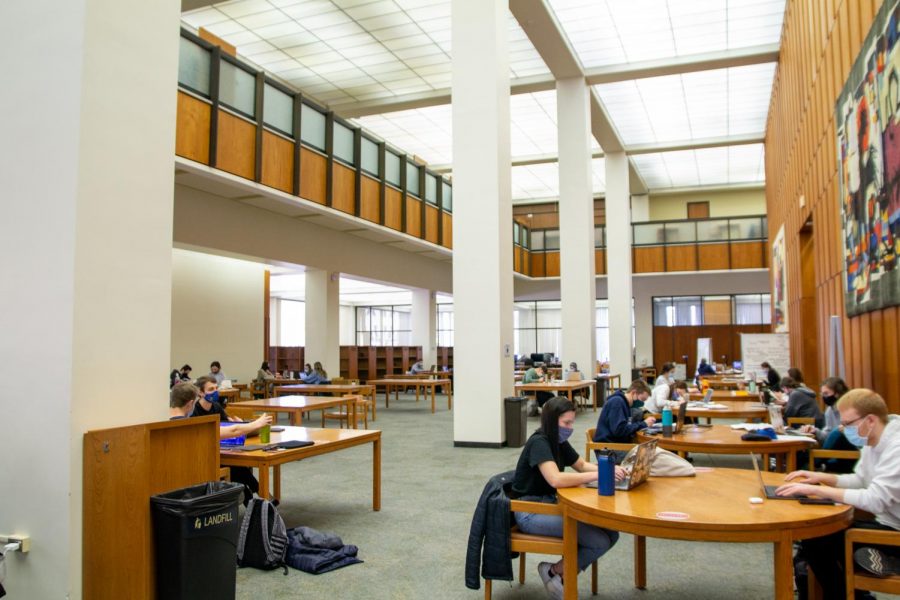Pitt opens study spaces, limited dine-in seating to student applause
John Blair | Staff Photographer
Pitt moved from Elevated Risk to Guarded Risk last Thursday at 7 a.m., following the limited reopening of some dining and study spaces in mid-February. These study spots include the Cathedral of Learning, the William Pitt Union, Hillman Library and many other locations.
March 19, 2021
Campus study areas and dine-in locations opened their doors to Pitt students when the shelter-in-place order lifted on Feb. 16. This was just one move toward more in-person activities on campus.
Pitt moved from Elevated risk to Guarded risk last Thursday at 7 a.m. This follows the limited reopening of some dining and study spaces in mid-February. Students now have the ability to sit and enjoy their meals at tables, such as in The Eatery, The Hub at Posvar and the Petersen Events Center. There are more options for studying as well, such as the Cathedral of Learning, the William Pitt Union, Hillman Library, Lawrence Hall, Posvar Hall and the Chevron Science Center.
In the Guarded risk posture, most activities can occur in person with virtual options and limited restrictions. Shared spaces are opened and in-person classes are permitted, except for large lectures. The University said it made the decision to shift to Guarded risk when COVID-19 case numbers on campus remained low and stable.
Use of these facilities requires adherence to the policies put in place by the University, and Pitt spokesperson Pat McMahon said the University has confidence in the steps they have taken. He added that the dine-in and study spaces have limited occupancy, updated HVAC systems and installed plexiglass barriers as precaution.
“We monitor many factors on campus and in our surrounding areas, and will make adjustments if needed to support the health and safety of our communities,” McMahon said.
McMahon said the same health guidelines, such as time limits and wearing face coverings, remain in place at these locations even after the transition from Elevated to Guarded postures.
“Guidelines in place for dining and study spaces remain consistent to support safety protocols, including physical distancing,” McMahon said.
Bre Smith, a first-year psychology major, said the opening of these study spaces provides some sense of normality for her college experience. Smith said she has frequently used the dine-in and study areas since they opened.
“I am so happy that the spaces are open,” Smith said. “This semester I got a roommate, so it is nice to have somewhere to go to get some alone time or to do my classes when she also has classes going on in the room.”
Even if just for a few hours, Smith said, spaces provide her with a welcome reprieve from the dorm room she has become all too familiar with over the course of this year.
“I use the study spaces at least three to four times a week,” Smith said. “And, I’m normally in them from anywhere between one and four hours.”
Nina Duong, a junior economics major, said she supports opening these spaces and enjoys the convenience it offers her.
“I love that they have the option to sit. It’s an inconvenience to walk all the way up to the Pete, for example, just to have to walk all the way back, especially if I’m hungry,” Duong said. “Also, I think I would go crazy if I could not leave my room to do work. I have such a large chunk of time on the weekends with no classes and I can’t imagine being in my room that whole time, doing the same thing.”
Both Smith and Duong said when they go to a study room or a dine-in location, the COVID-19 guidelines are always communicated to them.
“The Union usually has no more than three people at a time in the quiet study room and the library has plastic guards on the desks of the ground floor,” Smith said.
Smith said the only improvement she’d like to see is more time to use these areas.
“I think the library should be open 24/7. I have early morning classes that I would prefer to do somewhere outside of my room that I am not able to and there are some nights I would want to be there longer,” Smith said.
Duong only had one request — to keep the study spaces open.
“I am so happy they are open and I hope they don’t close them,” Duong said.
McMahon said the University is always open to feedback and input from the campus community. They added that the response to these spaces opening has been overwhelmingly favorable.
“We welcome ongoing feedback from students to further strengthen campus services,” McMahon said, “We do not anticipate closing these spaces. Compliance with health and safety rules have been extremely high, and case counts remain low.”








